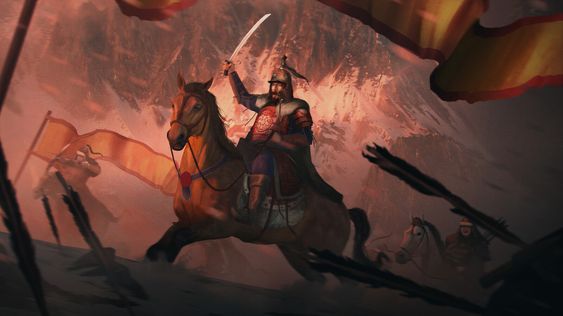
Genghis Khan at the Battle of Huan’erzui by Alexis Morand on ArtStation
At Yehuling (Fox Range) 1211, 100,000 Mongols defeat 500,000 Chinese
At the Battle of Huan’erzui (Badger’s Mouth) in February 1212, the Mongols under CHINGGIS KHAN delivered a legendary defeat to the field armies of the Jin dynasty in North China.
The Jin used the Mengan/Mouke system to organize their subjects (especially in the border regions), which made military mobilization much easier. It was a decimal system that was based on tribal structure. The smallest unit was a Puliyen, which contained about 50 households and was lead by a headman of the same title. In wartime this became a fighting unit, and the headman became the officer. Every male member of the group had to provide military service and bring along at least one auxiliary soldier (usually a male slave). A Mouke was a larger unit made up of about 5 or 6 Puliyen or 300 households (often less), lead by an officer of the same title. A single Mouke usually constituted one walled town or village. A Mengan was a unit of 1,000 households (technically. Often it was less), and a Wanhu was 10,000 households (the equivalent of Mongol Tumens). In times of emergency the Jin would also conscript local Chinese peasants.
To beef up border defense the Jin also used nine Jiu units (also known as Juyin). These were ethnically mixed mercenary armies made up of Khitans, Tanguts, Turks, Mongols, etc. The Jiu armies surrendered or defected to the Mongols almost immediately. Genghis Khan himself was part of the Jin border defense system early in his career when he helped the Jin fight the Tatars and was granted the title “Ja’ud-qori”, which meant something like “commander of the frontier”.
Although the Mongols had advanced as far as the capital of North China’s JIN DYNASTY in 1211, they withdrew to the Jin frontier in Inner Mongolia that winter. In February 1212 the Mongols took the border prefecture of Huanzhou (near modern Zhenglan Qi) and besieged Fuzhou. The Jin emperor dispatched the bandit-suppression commissioner, Heshilie Jiujin, to lead the crack cavalry of the ruling Jurchen people and KITANS, assisted by Han (ethnic Chinese) infantry under two civil officials, Duji Qianjianu and Hu Sha. The force totaled several hundred thousand.
Leaving Hu Sha with infantry at Huihebao Fort (modern Huai’an), Heshilie Jiujin and Duji Qianjianu advanced past Yehuling (Fox Range) into Inner Mongolia. While certain Kitan commanders advocated a surprise attack, Heshilie Jiujin preferred to advance his troops in a body and sent an envoy to Chinggis Khan denouncing his invasion. The Mongols besieging Fuzhou (in Inner Mongolia) had been eating breakfast but formed up quickly after hearing of the Jin advance. Although the Mongols were vastly outnumbered, MUQALI, Chinggis Khan’s trusted NÖKÖR (companion), led a cavalry charge, discomfiting the Jin ranks. The main Mongol force then moved up to shatter the Jin troops. Pursuing the fugitives more than 48 kilometers (30 miles) they met Hu Sha’s rear guard at Huihebao Fort, crushing it. The flower of Jin soldiery was destroyed in this battle, which became legendary among the Mongols. The victory was attributed to the fighting qualities of the Mongol cavalry, Heshilie Jiujin’s excessive caution and reliance on numbers, and the disaffection of many Kitan commanders, who resented Jurchen control.
What went wrong with the Badger mouth for the Chinese was probably an issue of training. The Jin likely had an army composed largely of peasant levies rather than professional soldiers. The Mongols on the other hand were a fairly lethal force of highly trained men. If one looks at the numbers a whole lot of Chinese soldiers survived the battle. I suspect they broke really quickly, probably in the face of the Mongol ferocity. The Mongols were famous for their discipline. The Mongol troops of Genghis were probably the most disciplined troops in the world at the time, and likely right up there among the most disciplined forces ever.
The Mongols may also have underestimated the Mongols in terms of man-to-man fighting. Bottle-necking an enemy (as they did at the pass) only works if your own soldiers are man-to-man equal to or superior than the enemy (so you can off-set superior numbers). Here it was a rough analogy to Thermopylae, except the Mongols were the Spartans, not the Chinese. The poorly trained Chinese troops probably became fodder for the Mongol troops, and likely couldn’t bring their over-whelming numbers to bear in any relevant way such as surrounding or flanking the Mongols. It came down to a largely man-to-man slug, and the Mongols chewed up the Chinese. As the Chinese losses mounted, they probably broke in fear, because their discipline would likely have been very poor. As the old adage goes, “you can give a peasant a sword, but it won’t make him a warrior”.
The battle is a classical example of how quality of troops can easily offset quantity, particularly in the right conditions. My opinion of the battle is that the Chinese massively under-estimated Mongol troops and made a horrendous error in choosing their battleground (though given the Mongol superiority in mobility, they may not have had a choice).
And in the narrow confines of the pass, the battle would have been decided not by cavalry charges (where the Iron cavalry would have been useful) but by the sheer individual and group fighting ability. Plus the Mongol superiority in archers would have devastated the Chinese troops. The Mongols were like the Persian Immortals, highly skilled with bow and melee weapons. The fact remains, that a significant number of Chinese troops survived the battle, and yet were not able to reform and take the exhausted Mongols. This indicates that they broke, which means their comparative discipline was poor. Maybe the Chinese elite troops got slaughtered, nobody denies the heavy Mongol losses and only the non-elite troops broke. Either way the difference in discipline shows.